David Julius and Erdem Patapotian (born in Beirut, Lebanon) discovered the receptors TRPV1, TRPM8 made it possible to understand how heat, cold and mechanical force can initiate nerve impulses that allow us to sense and adapt to the world around us And there is also an Israeli point
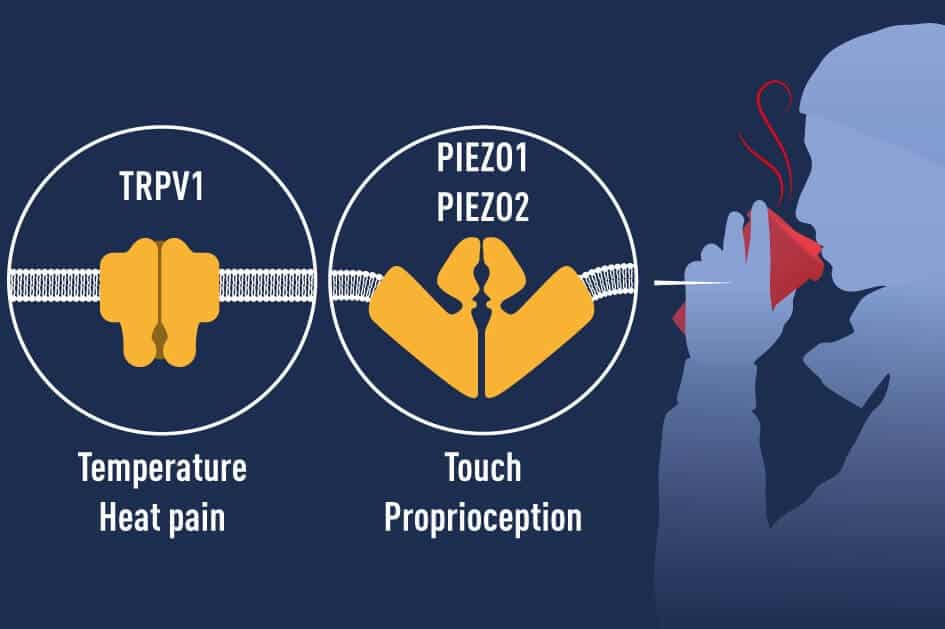
The Nobel Prize in Physiology or Medicine for 2021 was awarded jointly and in equal parts to David Julius (David Julius) and Ardem Patapoutian (Ardem Patapoutian) for the discoveries of receptors and ion channels for temperature and touch.
Ardem Patapoutian was born in 1967 in Beirut, Lebanon. He received his PhD in 1996 from the California Institute of Technology, Pasadena, USA. He became a postdoctoral fellow at the University of California, San Francisco. Since 2000 he has been a professor at the Scripps Research Institute, La Jolla, California.
The discoveries of TRPV1, TRPM8 receptors by this year's laureates allowed us to understand how heat, cold and mechanical force can initiate neural impulses that allow us to sense and adapt to the world around us.
The Israeli point
The Israeli point regarding this particular Nobel Prize is found in the name of the receptors TRPV1, TRPM8 which belong to the family of cation (calcium) channels. Transient receptor potential channel which is called by the same name established by an Israeli scientist Prof. Baruch Minka from the School of Medicine of the Hebrew University who discovered the first of them as being involved in the light receptors in the eyes of Drosophila. (Thanks to Ofer Markman).
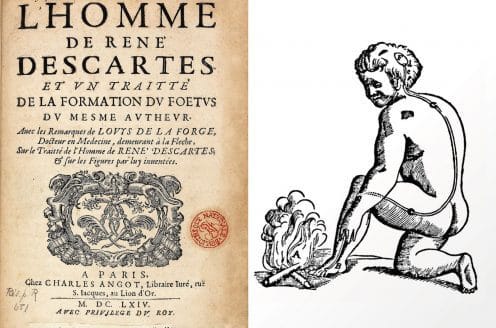
Our ability to sense heat, cold and touch is essential to our survival and supports our interactions with the world around us. In our daily lives we take these sensations for granted, but have you ever thought about how our nerve impulses cause the perception of temperature and pressure we experience? An answer to this question was provided by this year's Nobel laureates. David Julius used the substance capsaicin (capsaicin, a fatty organic compound responsible for the spiciness of the chili pepper and other types of pepper) in order to identify a sensory factor in the nerve endings of the skin in response to heat. Erdem Patapotian used stress-sensitive cells to identify a new family of sensory factors that respond to mechanical stimulation in the skin and internal organs. These groundbreaking discoveries launched extensive research activities that led to a rapid surge in the scientific world's insights into how our nervous system responds to heat, cold, and mechanical force. The laureates identified vital missing chain links within our understanding of the complex interrelationships between our senses and our environment.
How do we experience the world?
One of the great mysteries facing humanity is the question of how we perceive our environment. The mechanisms underlying our senses have intrigued humanity for thousands of years, for example, how light is detected by our eyes, how sound waves affect our inner ear, and how various chemical compounds react with receptors in our nose and mouth, thereby affecting the smell and taste we perceive . We also have other methods by which we experience the world around us. Imagine you are walking barefoot on a lawn on a hot summer day. You can feel the heat of the sun, the gusts of wind, and the thorns of the grass under your feet. This sensing of temperature, touch and movement is essential for our adaptation to the ever-changing environment.
In the seventeenth century, the philosopher René Descartes imagined wires connecting different parts of the skin to the brain. In this way, a foot touching the flame will send a mechanical signal to the brain (Figure 1). Later discoveries revealed that there are dedicated sensory neurons that perceive the changes occurring in our environment. Joseph Erlanger and Herbert Spencer Gesser won the 1944 Nobel Prize in Physiology or Medicine for their discovery of different types of sensory nerve fibers that respond to a defined stimulus, for example, in response to painful and non-painful touch. Since then, it has been demonstrated that nerve cells are specially designated cells for detecting and transmitting different stimuli, which allow us to perceive and understand the subtleties of our environment; For example, our ability to feel changes in the texture of surfaces with our fingers, or our ability to distinguish both pleasant and painful heat.
Before the discoveries of David Julius and Erdem Patapotian, our understanding of how our nervous system senses and interprets the stimuli from our environment included a fundamental unsolved question: How are stimuli of temperature and mechanical force converted into electrical impulses in the nervous system?
Science is heating up!
In the late nineties of the last century, David Julius from the University of California, San Francisco in the USA, recognized the possibility of serious progress in this field by examining how the compound capsaicin, found in chili peppers, causes the sensation of spiciness that we feel . At this point, it was already known that the compound capsaicin activates nerve cells that cause a sensation of pain, but the exact chemical way in which this process occurs has not yet been fully revealed. Julius and the team of researchers in his laboratory created a library of millions of DNA segments that correspond to genes that are expressed in sensory neurons responsible for causing pain, heat and touch. Julius and his colleagues hypothesized that the library would include a DNA segment encoding the protein capable of reacting with capsaicin. They expressed genes defined from this library inside cultured cells that normally do not respond to the compound. After feverish research, a single gene that reacts with capsaicin was located (Figure 2). Finally, the sensory garden is found in capsaicin. Further experiments revealed that the gene located encodes a novel ion channel protein called TRPV1. When Julius investigated the protein's ability to respond to heat, he realized that he had discovered the heat-sensing receptor that operates at temperatures perceived as painful (Figure 2).
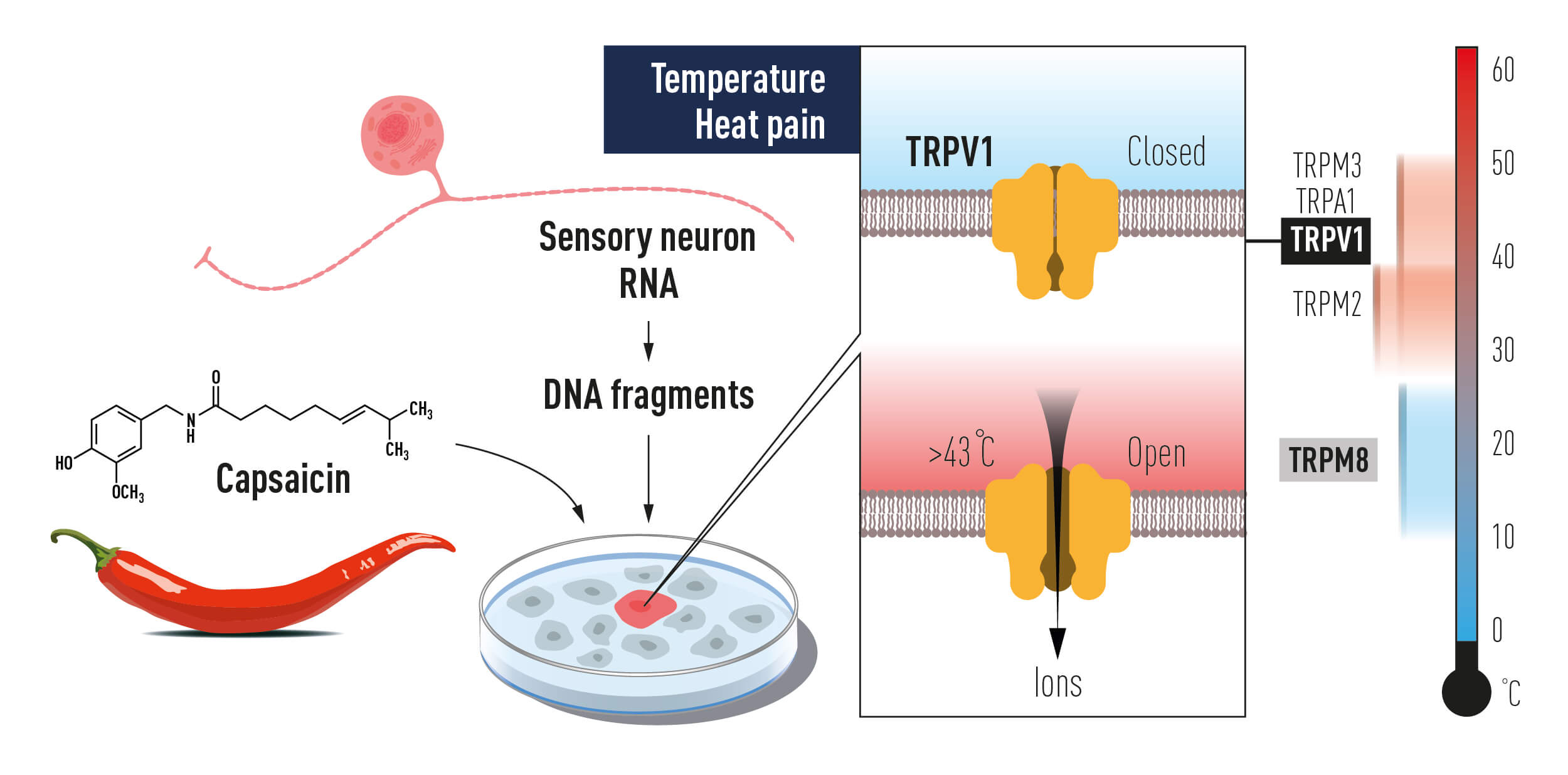
The discovery of this ion channel was a major breakthrough that led to the identification of other temperature sensing receptors. Unrelatedly, both David Julius and Erdem Patapotian used the chemical menthol to identify TRPM8, a receptor shown to be activated by cold. Additional ion channels similar to the previous ones (TRPV1, TRPM8) have been identified and found to be activated by a range of different temperatures. Many laboratories are running vigorous research programs to investigate the roles of these channels in heat sensing by using genetically engineered mice that lack these new genes. David Julius's discovery of TRPV1 was the breakthrough that allowed us to understand how changes in temperature can induce electrical signals in the nervous system.
Research under pressure!
While the mechanisms for temperature sensing have been uncovered, the mechanism by which mechanical stimulation is converted into the senses of touch and pressure still remains a mystery. Researchers previously found mechanosensory factors in bacteria, but the mechanisms underlying contact in vertebrates still remain unknown. Erdem Patapotian wanted to identify the elusive receptors activated by mechanical stimulation. The researchers first identified a cell line that emitted a measurable electrical signal when a micropipette touched defined cells. The researchers hypothesized that the receptor operated by mechanical force is of the ion channel type, and in the next step they identified seventy-two genes encoding suitable receptors. These genes were inactivated one after the other in order to identify the only gene responsible for sensitivity to mechanical force in the tested cells. After extremely intensive research work, Patapotian and his colleagues were able to identify a single gene whose inactivation prevented the emission of the electrical signal in contact with the micropipette. As part of these experiments, a new and completely unknown ion channel was identified which is responsible for mechanical sensing, and which was given the name Piezo1, after the Greek word for pressure. Subsequently, a similar ion channel was identified and named Piezo2. Sensory neurons were found to express high levels of Piezo2, and further studies showed that these ion channels are directly activated by a response to pressure exerted on cell membranes (Figure 3).
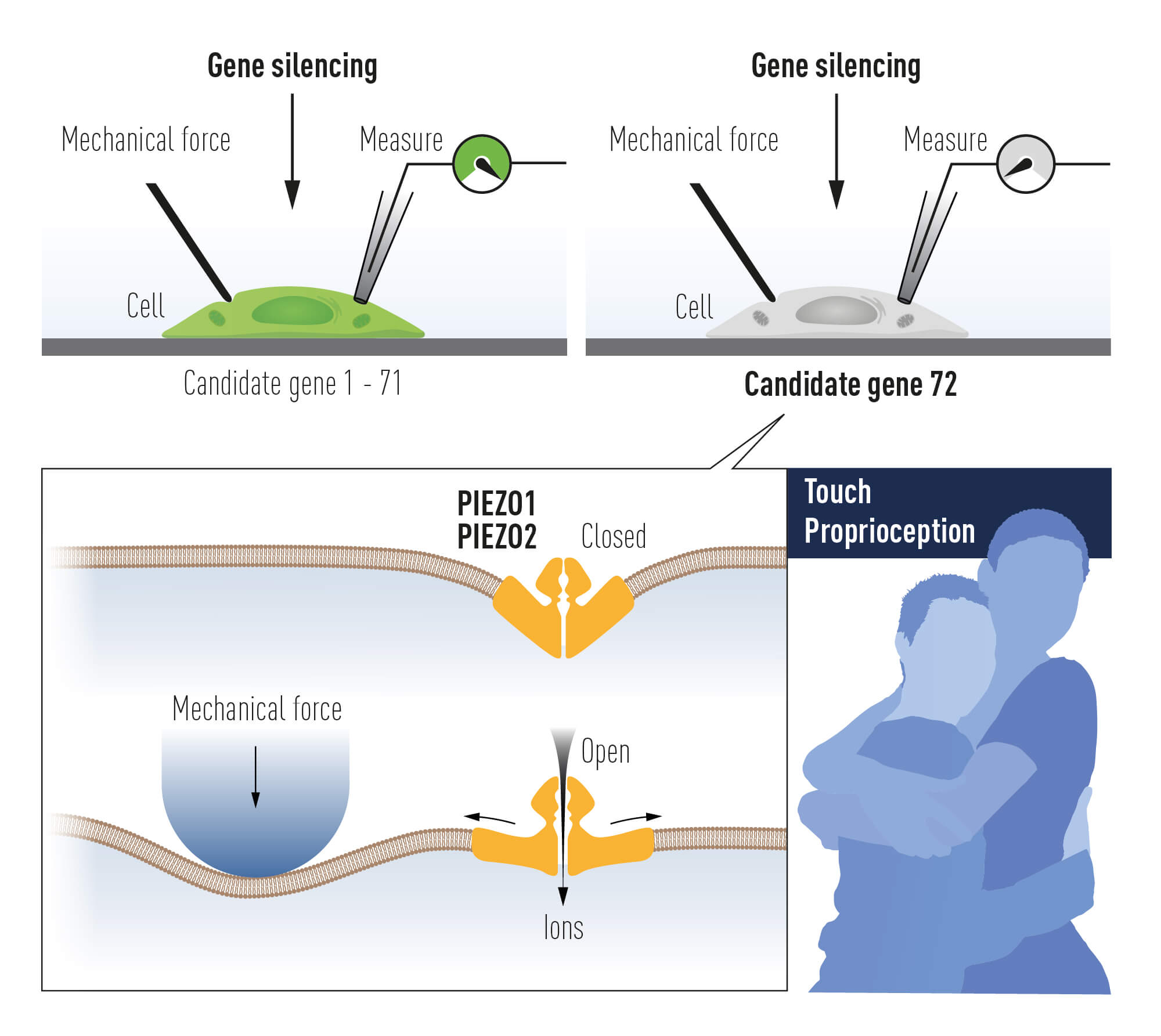
Patapotian's breakthrough led to many papers by him and other researchers, demonstrating that the Piezo2 ion channel is essential for touch whispering. Moreover, the researchers showed that Piezo2 plays a major role in the very important sense of the body's position and movement, which is known as proprioception In further studies, these channels were revealed to be responsible for the regulation of other important physiological processes, including blood pressure, breathing and bladder control.
Everything makes sense!
The groundbreaking discoveries of TRPV1, TRPM8 and Piezo ion channels revealed by this year's Nobel laureates allowed us to understand how heat, cold and mechanical force can initiate the same nerve impulses that allow us to perceive and adapt to the world around us. These channels are essential for our ability to understand the concept of heat and feel physical contact, that is, the ability to feel the position and movement of our body parts. These channels also contribute to many other physiological functions that depend on temperature sensing or mechanical stimulation. The insights obtained from this research can be used by us to develop treatments for a wide variety of diseases, including chronic pain (Figure 4).
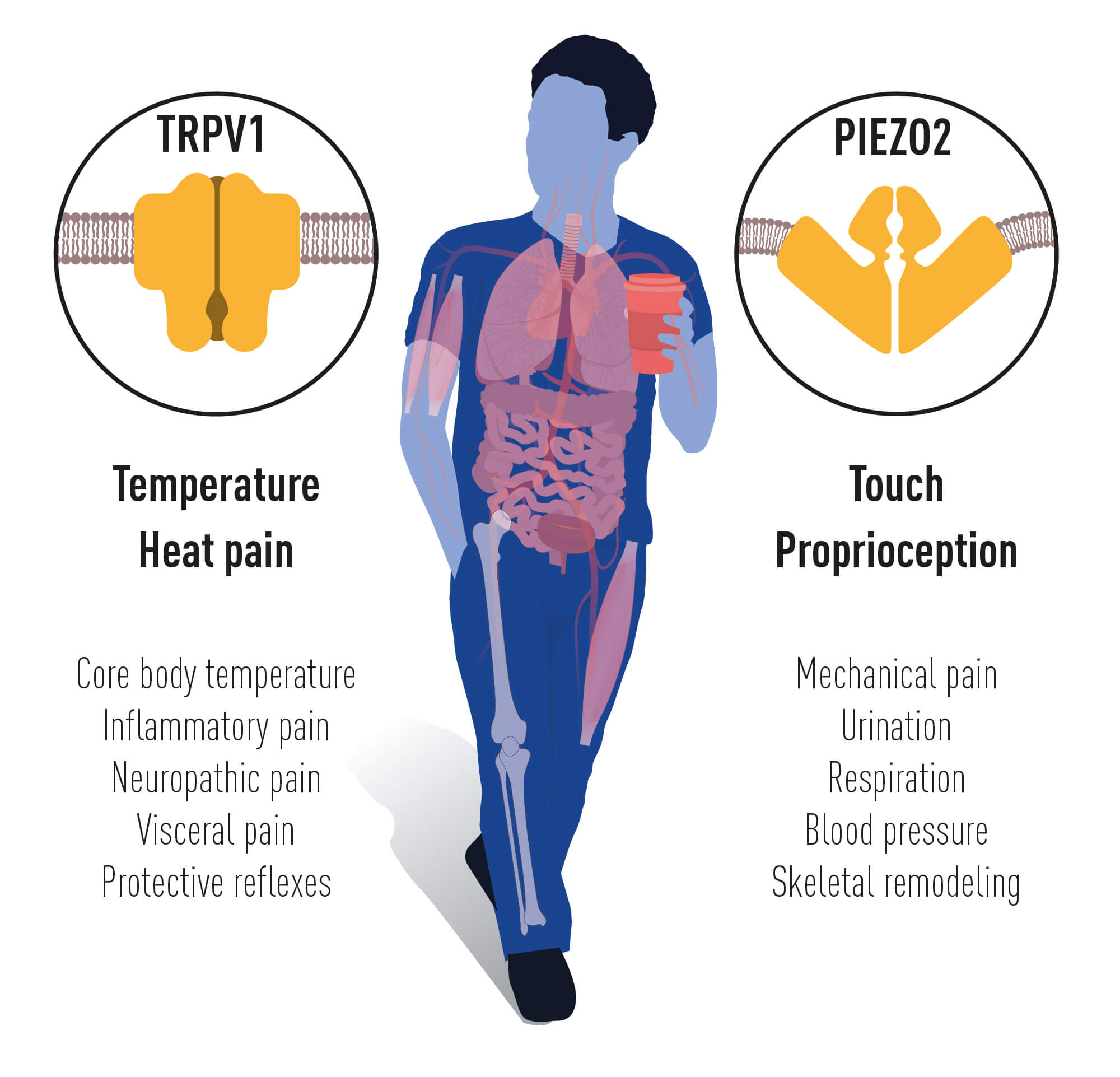
David Julius was born in 1955 in New York, USA. He received his doctorate in 1984 from the University of California, Berkeley, and became a postdoctoral fellow at Columbia University in New York. In 1989, Professor Julius was recruited to the University of California, San Francisco.
Ardem Patapoutian was born in 1967 in Beirut, Lebanon. He received his PhD in 1996 from the California Institute of Technology, Pasadena, USA. He became a postdoctoral fellow at the University of California, San Francisco. Since 2000 he has been a professor at the Scripps Research Institute, La Jolla, California.
Key publications
Caterina MJ, Schumacher MA, Tominaga M, Rosen TA, Levine JD, Julius D. The capsaicin receptor: a heat-activated ion channel in the pain pathway. Nature 1997:389:816-824.
Tominaga M, Caterina MJ, Malmberg AB, Rosen TA, Gilbert H, Skinner K, Raumann BE, Basbaum AI, Julius D. The cloned capsaicin receptor integrates multiple pain-producing stimuli. Neuron 1998:21:531-543.
Caterina MJ, Leffler A, Malmberg AB, Martin WJ, Trafton J, Petersen-Zeitz KR, Koltzenburg M, Basbaum AI, Julius D. Impaired nociception and pain sensation in mice lacking the capsaicin receptor. Science 2000:288:306-313
McKemy DD, Neuhausser WM, Julius D. Identification of a cold receptor reveals a general role for TRP channels in thermosensation. Nature 2002:416:52-58
Peier AM, Moqrich A, Hergarden AC, Reeve AJ, Andersson DA, Story GM, Earley TJ, Dragoni I, McIntyre P, Bevan S, Patapoutian A. A TRP channel that senses cold stimuli and menthol. Cell 2002:108:705-715
Coste B, Mathur J, Schmidt M, Earley TJ, Ranade S, Petrus MJ, Dubin AE, Patapoutian A. Piezo1 and Piezo2 are essential components of distinct mechanically activated cation channels. Science 2010:330: 55-60
Ranade SS, Woo SH, Dubin AE, Moshourab RA, Wetzel C, Petrus M, Mathur J, Bégay V, Coste B, Mainquist J, Wilson AJ, Francisco AG, Reddy K, Qiu Z, Wood JN, Lewin GR, Patapoutian A. Piezo2 is the major transducer of mechanical forces for touch sensation in mice. Nature 2014:516:121-125
David Julius was born in 1955 in New York, USA. He received his doctorate in 1984 from the University of California, Berkeley, and became a postdoctoral fellow at Columbia University in New York. In 1989, Professor Julius was recruited to the University of California, San Francisco.

One response
Thanks for the article.
Note - Of course, genes that react were not found, but genes that code for proteins/receptors that react